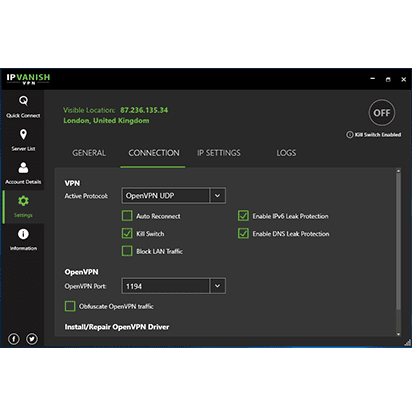

- #IPVANISH WILL NOT CONNECT TO OPENVPN ON MAC HOW TO#
- #IPVANISH WILL NOT CONNECT TO OPENVPN ON MAC FREE#
If you aren’t sure which you’d like, reference the image above to see the differences. redirect-gateway def1: This is what determines if you are configuring a split-tunnel or full-tunnel VPN.YOUR_SERVER_IP: This should be the DDNS hostname that you configured.We need to change the items below that are highlighted in pink. This document shouldn’t be shared with anyone other than users who you would like to authenticate with your VPN. By default, you will receive a default OpenVPN configuration file with a unique certificate at the bottom. We will only be editing the OpenVPN.ovpn file, so open that file with a text editor.ġ1. Open the VPN Server application and select OpenVPN. It’s also important to note that the DDNS provider is irrelevant, you just need to ensure that you have a DDNS hostname configured!ĩ. Simply use your external IP address as YOUR_SERVER_IP. If you are absolutely positive that you have a static external IP address that never changes, you do not have to setup DDNS. If you’d like to use DuckDNS, I wrote up a tutorial on how you can do it here.
#IPVANISH WILL NOT CONNECT TO OPENVPN ON MAC FREE#
If you’d like to configure DDNS using a free hostname, you can follow Synology’s instructions here. Most people have dynamic external IP addresses, so creating a DDNS hostname is required because you need to ensure that you are always accessing your external IP address. Before we get into the steps, you need to ensure that you have DDNS configured. Now that we have our server configured, we need to modify our configuration file. In the example below, 192.168.1.220 is the IP address of my Synology NAS.Īssuming that you were able to open UDP port 1194 and configure the Synology firewall rule successfully, the port configuration is now complete! Create a port forwarding rule for UDP port 1194 to your Synology NAS’s IP address.
#IPVANISH WILL NOT CONNECT TO OPENVPN ON MAC HOW TO#
This process requires you to have a static IP address setup.If you don’t currently have a static IP address setup, read how to set up a static IP address here.Ĩ. This is a great guide that shows how to port forward on a few different brands of routers, but the best thing to do is try and google the name of your router and port forwarding. Now, port forwarding will be completely different on every brand’s router settings page. If you’d like to do it this way, you can read Synology’s help article here. However, there is a lot of debate on the security of UPnP, so I will not be going over it in this tutorial. If you have a UPnP compatible router, it’s very easy to set this up. Synology has UPnP functionality, which gives your NAS the ability to open ports on your router automatically. We now need to port forward UDP port 1194 on our router to our Synology NAS.

We just configured our Synology firewall to allow connections on UDP port 1194.


 0 kommentar(er)
0 kommentar(er)
